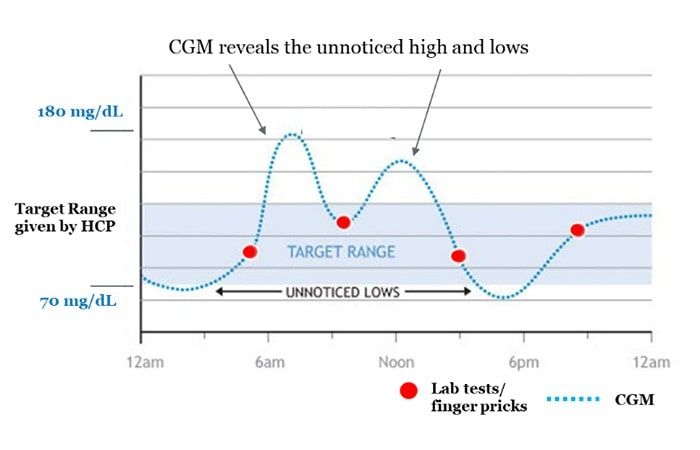Introduction To CGM
- Home
- Introduction To CGM

Continuous Glucose Monitoring (CGM)
Continuous glucose monitoring (CGM) is a rapidly emerging tool in the diagnosis and management of diabetes. They can be a lifesaving gadget for some individuals with brittle diabetes. Until now, patients and clinicians followed some standard checks to measure glucose levels like fasting blood sugar (FBS), postprandial glucose (PPG), HbA1c that would give an overview of Diabetes. These tests only provide glucose readings at that point in time thus, lack the capacity of providing the trends or pattern of glucose levels throughout one whole day and many such days together.(see image)
CGM works through the application of a sensor unit which has a small filament inserted under the skin. This filament is programmed to check your interstitial fluid sugar readings every 1,5 or 15 minutes depending on the sensor. So if a sensor checks the sugar every 15 min, it could give 96 readings in a day and around 1350 readings in a total of 2 weeks. The measured sugar values are transferred to a small chip, which is a part of the sensor unit outside your skin. A separate reader, when placed in proximity to the sensor unit will transfer the readings to the reader. The readings are then visualised on the computer screen after connecting the reader to the computer. The doctor will also be interpreting an average of all daily patterns, which are summated as a continuous graphical pattern throughout the day (Daily pattern). In addition, an average of all the daily patterns is projected as an AGP (Ambulatory glucose profile). This will give the doctor intricate details of the patterns of blood glucose, resulting in precision management of a patient’s Diabetes.
Join Our Newsletter
To get the latest updates on better diabetes management, subscribe to our newsletter.
© 2020 drkalyan.com All Rights Reserved
